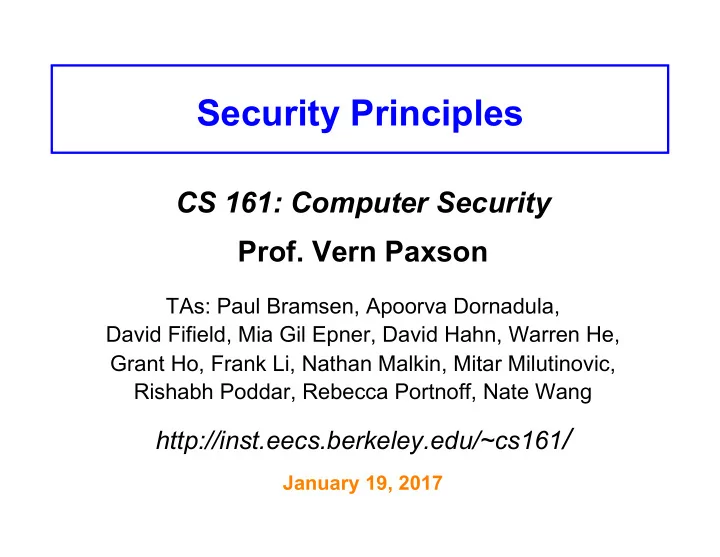

Security Principles CS 161: Computer Security Prof. Vern Paxson TAs: Paul Bramsen, Apoorva Dornadula, David Fifield, Mia Gil Epner, David Hahn, Warren He, Grant Ho, Frank Li, Nathan Malkin, Mitar Milutinovic, Rishabh Poddar, Rebecca Portnoff, Nate Wang http://inst.eecs.berkeley.edu/~cs161 / January 19, 2017
TL-15
TL-30
TRTL-30
TXTL-60
“ Security is economics. ”
What is this program able to do? Can it leak your files elsewhere? Can it delete all of your files? Can it send spam? YES. Why? Can it add a new executable to your search path?
What does this program need to be able to do? Maybe: access screen manage a directory of downloaded files access config & documentaIon files open connecIons for a given set of protocols receive connecIons as a server
“ Least privilege. ”
Check for Understanding • We’ve seen that laptop/desktop platforms grant applications a lot of privileges • Quiz: Name a platform that does a better job of least privilege
Thinking About Least Privilege • When assessing the security of a system’s design, identify the Trusted Computing Base ( TCB ). – What components does security rely upon? • Security requires that the TCB: – Is correct – Is complete (can’t be bypassed) – Is itself secure (can’t be tampered with) • Best way to be assured of correctness and its security? – KISS = Keep It Simple, Stupid! – Generally, Simple = Small • One powerful design approach: privilege separation – Isolate privileged operations to as small a component as possible
Sandbox Sandbox Rendering Web browser Engine Rendering Engine Trusted Web Computing Site Base IPC Web Browser IPC HTML, ¡JS, ¡... Rendered ¡Bitmap Browser Rendering Kernel Engine Browser ¡Kernel HTML, ¡JS, ¡... Rendered ¡Bitmap Browser ¡Kernel User Files “Drive-by malware”: malicious web page exploits browser bug to infect local files
The Chrome browser Sandbox Goal: prevent “drive-by malware”, where a malicious Rendering Engine web page exploits a browser bug to infect local files IPC Rendered ¡Bitmap HTML, ¡JS, ¡... TCB (for this property) Browser ¡Kernel
The Chrome browser 70% of vulnerabilities are Sandbox in the rendering engine. Rendering 1M+ lines of code Engine IPC Rendered ¡Bitmap HTML, ¡JS, ¡... Browser ¡Kernel
“ Ensure complete mediation. ” For every requested action, check authenticity , integrity , authorization
Ensuring Complete Mediation • To secure access to some capability/resource, construct a reference monitor • Single point through which all access must occur – E.g.: a network firewall • Desired properties: – Un-bypassable ( “ complete mediation ” ) – Tamper-proof (is itself secure) – Verifiable (correct) – (Note, just restatements of what we want for TCBs) • One subtle form of reference monitor flaw concerns race conditions …
TOCTTOU Vulnerability procedure withdrawal(w) // contact central server to get balance 1. let b := balance Suppose that here an attacker arranges to suspend first call, and calls withdrawal again 2. if b < w, abort concurrently // contact server to set balance 3. set balance := b - w 4. dispense $w to user TOCTTOU = Time of Check To Time of Use
public void buyItem(Account buyer, Item item) { if (item.cost > buyer.balance) return; /* they can’t afford it */ buyer.possessions.put(item); /* provide item */ buyer.possessionsUpdated(); /* freshen screen */ buyer.balance -= item.cost; /* deduct cost */ buyer.balanceUpdated(); /* freshen screen */ What if an uncaught } exception happens here ?
“ Separation of responsibility. ”
Independent audit
Summary: Notions Regarding Managing Privilege • Least privilege – The notion of avoiding having unnecessary privileges • Privilege separation – A way to achieve least privilege by isolating access to privileges to a small Trusted Computing Base (TCB) • Separation of responsibility – If you need to have a privilege, consider requiring multiple parties to work together (collude) to exercise it
“ Defense in depth. ”
“ Company policy: passwords must be at least 10 characters long, contain at least 2 digits, 1 uppercase character, 1 lowercase character, and 1 special character. ”
“ Psychological acceptability. ”
What a piece of work is a man! how Noble in � Reason! how infinite in faculty! in form and moving � how express and admirable! in Action, how like an Angel! � in apprehension, how like a God! � -- Hamlet Act II, Scene II “ Humans are incapable of securely storing high-quality cryptographic keys, and they have unacceptable speed and accuracy when performing cryptographic operations. (They are also large, expensive to maintain, difficult to manage, and they pollute the environment. It is astonishing that these devices continue to be manufactured and deployed. But they are sufficiently pervasive that we must design our protocols around their limitations.) ” -- Network Security: Private Communication in a Public World , � Charlie Kaufman, Radia Perlman, & Mike Speciner, 1995
“ Consider human factors. ”
Summary: Dealing with Users • Psychological acceptability – Will users abide a security mechanism, or decide to subvert it? • Consider human factors – Does a security mechanism assume something about human behavior when interacting with the system that might not hold, even in the absence of conscious decisions by the users to subvert
“ Only as secure as the weakest link. ”
“ Don’t rely on security through obscurity. ”
“ Trusted path. ” User needs to know they’re talking w/ legit system. System needs to know it’s talking w/ legit user. These channels should be unspoofable & private.
Recommend
More recommend